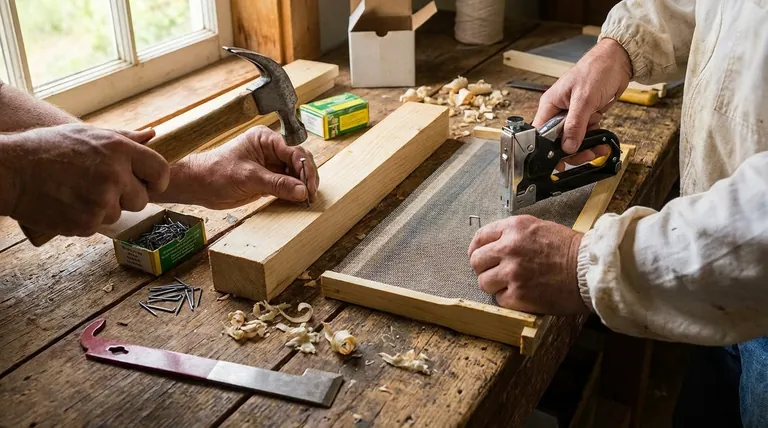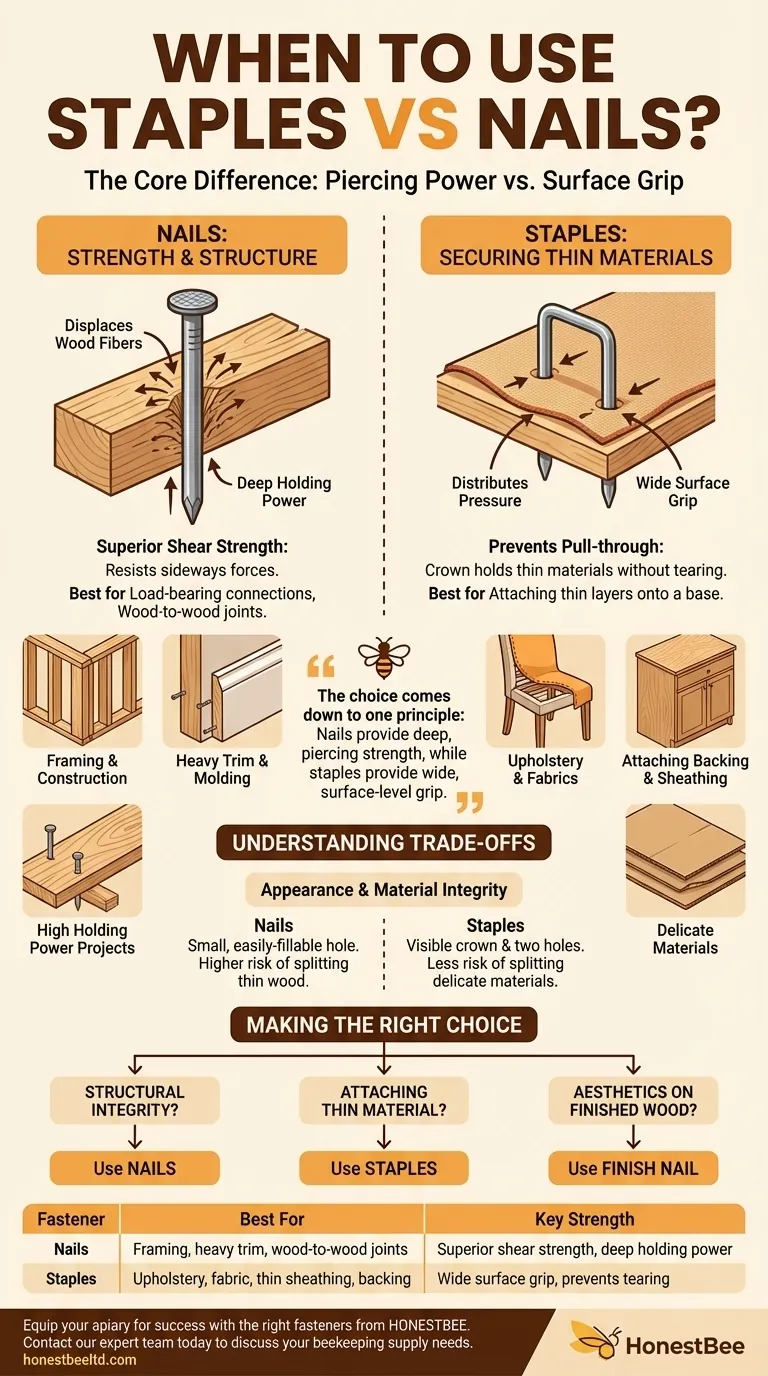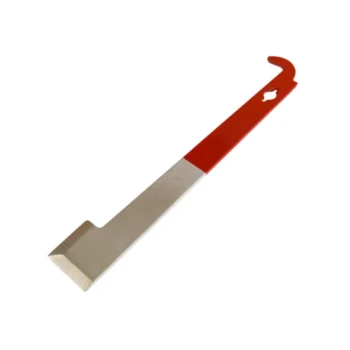In short, use nails for their structural strength and staples for fastening thin materials. Nails excel at joining wood to wood, providing deep holding power that resists shearing forces. Staples, with their broad crown, are designed to secure materials like fabric, upholstery, or thin sheathing onto a wood surface without tearing through them.
The choice between a nail and a staple comes down to one core principle: Nails provide deep, piercing strength, while staples provide wide, surface-level grip. Understanding this difference is key to a professional and durable finish.

The Core Difference: Piercing Power vs. Surface Grip
To select the right fastener, you must first understand how each one fundamentally works. Their shapes dictate their function.
How Nails Work
A nail is a single, thick shank of metal. It works by displacing wood fibers as it is driven in, creating immense friction along its length.
This design gives it superior shear strength, which is the ability to resist sideways forces that could slide one piece of wood against another.
How Staples Work
A staple has two legs connected by a "crown." The legs provide holding power, but the crown is the critical feature.
The crown distributes the fastening pressure across a wider surface area. This prevents the fastener from pulling through thin or delicate materials like fabric, cardboard, or thin plywood.
When to Choose Nails: Strength and Structure
Nails are the fastener of choice when the connection itself is load-bearing or needs to resist movement and twisting forces.
Framing and Construction
This is the classic use case for nails. Joining studs, joists, and rafters requires the deep holding power and shear strength that only nails can provide.
Heavy Trim and Molding
For substantial pieces like baseboards or window casings, nails provide the necessary strength to hold the wood securely in place and pull it tight against the wall.
Projects Requiring High Holding Power
Anytime you are joining two pieces of solid wood that need to act as a single unit, a nail is almost always the correct answer.
When to Choose Staples: Securing Thin Materials
Staples are superior when your primary goal is to attach a thin layer of one material onto a thicker, structural base.
Upholstery and Fabrics
Staples are essential for upholstery. The wide crown holds the fabric securely against the frame without ripping the delicate fibers, which a nail head would easily do.
Attaching Backing or Sheathing
When affixing a thin plywood back to a cabinet or house wrap to a wall, staples are fast and effective. They hold the thin sheet material flat against the frame.
Understanding the Trade-offs: Appearance and Material Integrity
Beyond function, you must consider the final look and the impact on your material.
Surface Damage and Visibility
Nails leave a single, small hole that can be easily filled with wood putty and concealed.
Staples leave two smaller holes and a visible crown on the surface. This is often more difficult to hide and can damage the appearance of finished wood.
Risk of Splitting
Because of their thicker diameter, nails have a higher risk of splitting thin or delicate pieces of wood, especially near the end of a board.
Fine-wire staples, conversely, can often fasten delicate materials without causing them to split.
Making the Right Choice for Your Project
Use these guidelines to make a clear decision based on your specific goal.
- If your primary focus is structural integrity (like building a frame): Use nails for their superior shear strength and deep holding power.
- If your primary focus is attaching a thin material to a surface (like upholstery or plywood backing): Use staples to distribute pressure and prevent tearing the material.
- If your primary focus is aesthetics on finished wood (like fine trim): Choose a finish nail for its small, easily-fillable hole, as a staple is more visible.
Choosing the correct fastener is the foundational step toward a professional and long-lasting result.
Summary Table:
| Fastener | Best For | Key Strength |
|---|---|---|
| Nails | Framing, heavy trim, wood-to-wood joints | Superior shear strength and deep holding power |
| Staples | Upholstery, fabric, thin sheathing, backing | Wide surface grip that prevents tearing |
Equip your apiary for success with the right fasteners from HONESTBEE.
Whether you're building durable hive bodies with the structural strength of nails or securing protective covers with the gentle grip of staples, using the correct fastener is crucial for longevity and efficiency. As a trusted wholesale supplier for commercial apiaries and beekeeping equipment distributors, HONESTBEE provides the high-quality fasteners and equipment you need for professional, long-lasting results.
Contact our expert team today to discuss your beekeeping supply needs and streamline your operations.
Visual Guide

Related Products
People Also Ask
- What is a beekeeper tool? The Essential Multi-Purpose Lever for Hive Management
- How can a hive tool be cleaned and sterilized? A Beekeeper's Guide to Disease Prevention
- What is the function of a hive tool in beekeeping? The Essential Multi-Purpose Lever for Your Hive
- Why is a hive tool necessary for beekeeping? Your Essential Key to Opening the Hive
- What is a hive tool used for? The Essential Multi-Tool for Every Beekeeper
